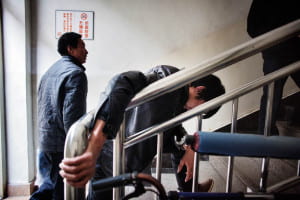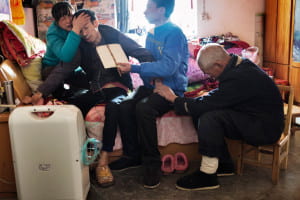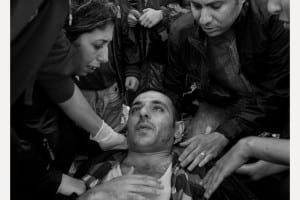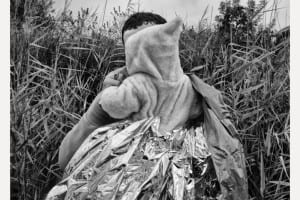I’ve always treated photography as “capturing a moment.” In addition, I’ve felt that photography has lost this aspect as of late. With camera phones taking exceptional pictures, and with digital SLRs becoming more ubiquitous and cheap, I’ve felt that photography has declined in some small way.
I’d have to say that viewing the VII website helped restore my faith in some way. Of course I seem pessimistic because I am biased towards a certain type of photography. Yet, VII photographers seem to be excellent at “capturing a moment” — the idea of freezing a moment of time in one frame, to convey an emotion or message. What is beautiful about the VII photos is that they speak for themselves. There might be some degree of artistic interpretation, but the idea seems to be about sharing stories and broadening the minds of viewers.
My other impression of VII photos is that they are very frank. “This is what life is,” is what the photos seem to say. I appreciate that, because they aren’t highly stylized. By that, I mean they aren’t heavily photoshopped to the point where they are considered digital art/digital painting. Of course, filters and effects can help adjust the mood or bring out certain tones, but it never seems overly done to the point where the photographer/editor created an entirely new photo.
I also appreciate VII’s commitment to sharing stories from people around the world, from all walks of life, instead of adhering to some corporate agenda. Of course, every company must have their own issues internally, but externally the collective seems like an honest effort to create discussions on happenings around the world.
One of the photographic works on the VII website that stunned me was by Sim Chi Yin. Titled, “Dying to Breathe,” Sim Chi Yin. Chi Yin, in my opinion, captures the raw heartache associated to illness; the numbing “knowingness” of an impending death; and how knowing you will die has already killed you, in some way. She follows the family of Mr. He Quanggui, 40 years-old. He’s been with his wife, Mi Shixiu, 36, for nearly 19 years. They have an 18 year-old son.
He Quanggui used to be a gold miner. The extreme conditions of his job lead him to develop silicosis. He can now barely breathe and uses a machine to help pump oxygen into his lungs. He consistently collapses, suffers from life-threatening illnesses, and attempts suicide. Fortunately, his family is there for him every step of the way.
The first photo from the collection that strikes me the most is of He Quanggui struggling to climb the stairs to see his doctor. We find out by the later photos that his lungs will need to be drained, but for now, this first photo simply captures He’s daily struggle. It’s not that he cannot walk up the stairs or is short of breath–he is severely handicapped from his disease. We can see by how he grips the railing, hunched over, almost collapsing. People near him can stand upright, yet he cannot. The photography frames He in a very simplistic way, again demonstrating the “frankness” that is pervasive throughout other VII photographer’s works. This is He, and this is his struggle.
The second photo that, quite honestly, wrenched my heart was He sitting with his wife, son, and father. His father had also worked in the mines, but fortunately he does not suffer from silicosis. The caption of the photo lets us know that He collapsed for the second time that morning. His wife holds him and cries; his son sits next to him; his father bends his head down in seriousness. This photo beautifully captures the severity of He’s disease and the effects it has on family. We can see that the end of the road is near for He, yet he is still alive. Therefore, he is suffering greatly.
The next photographer whose work I was struck by is that of Maciek Nabrdalik. Nabrdalik’s photo series, “Refugee Crisis,” is an ongoing work following refugees from the Middle East. We see them arriving on boats, traveling down empty roads, and sleeping on the ground. To summarize, they have nowhere to go, yet they are in dire need of a newer, safer home. Hence, the “crisis.”
One photo I found interested was of a man waking up after passing out. He is surrounded by several people. It is unclear whether or not he knows these people, or if they just helping him. His eyes are crossed, and the frame hugs tightly around his body. Typically I am not a fan of close cropping, yet this helps capture what it must be like to be surrounded by several people trying to bring you back to consciousness.
Another photo I wanted to point out was one of a father holding his baby, wrapped in a thermal blanket. Why is this important? Well, this is what they have to keep them warm–a thin foil-like layer. Of course, it will do it’s job, but is is enough? This photo is also “matter-of-fact,” but, it also inspires several questions. Where will they go? What will they do? What do they have? The refugee crisis is something we hear about every day, but not necessarily something us Americans deal with on a daily basis. Though, in other countries, natives encounter refugees every day. It is simply a part of life. Furthermore, this is a refugee’s life, one of nomadicity.

“Arriving at a hospital seven hours’ drive from his remote village in the mountains, former gold miner Mr He Quangui struggles at the foot of a flight of stairs to get to the room where he will be warded. He is almost totally out of breath. An air bubble had burst in his lung cavity, putting pressure on his lungs, the doctors told him. The doctor who received him took one look at the chest x-rays he brought with him and said ‘It’s a miracle you made it here.'”

“Collapsing a second time in the same day, shortly after trying to take a pee on a commode, He Quangui is struggling to breathe, his son He Jingbo fanning him with a piece of cardboard while his wife Mi Shixiu and father He Decheng hold him, crying. He eventually recovers his breath. But in the wee hours of the next morning, he tried to kill himself to end the suffering.”


Like you, I find “Dying to Breathe” a breathtaking work of journalism. You can read more about it here: http://lens.blogs.nytimes.com/2015/06/23/a-chinese-miner-with-a-heart-of-gold/
And that article also links the Nat Geo Proof blog, which ran a video on it and I recommend checking it out.
In your response to Nabrdalik, one comment quite piqued my attention. You write: “Typically I am not a fan of close cropping.” Why is that? Explain how you feel/what you think in response to such editing. And when does a tight crop work for you? Is it more about content/subject matter or about an emotional response, or about something else altogether?